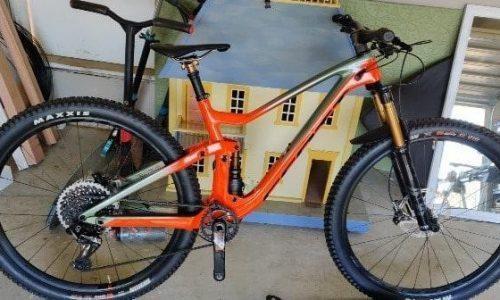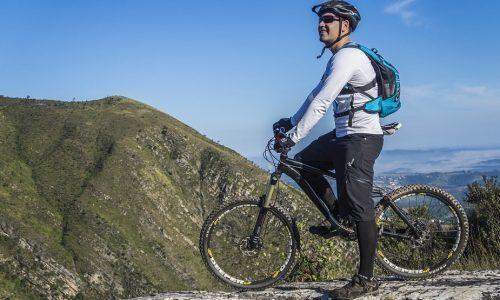Bikepacking is the new adventure cycling philosophy that combines mountain biking, bike touring, and camping. An important part of bikepacking is fitting all the gear on the bike.
Obviously, this requires a more specialized bike, so let’s take a look at some of the best bikes the industry has to offer.
The term bikepacking is appearing a lot in the world of cycling. Every day, more and more people are becoming interested in the type of cycling that combines mountain biking and bike touring with light camping.
This can be a great challenge, both mentally and physically. Can you imagine doing a 1000 km bike trip with a tent on the bike? That’s what bikepacking is all about. And for this long of a challenge, we need the best bike to do it.
Each bike must adapt to the terrain we are going to cover. It would not make sense to travel on paved terrain with a mountain bike, or gravel terrain with a road bike.
In this article, we will first start with the best bikepacking bikes on the market for 2021 and then explain what type of bikes are ideal for each type of route.
Editor’s Note: The article was updated in January 2021.
Below, I will describe the bikes that I consider to be the best for bikepacking, based on the type of bike, its quality, and divided by price.
Best bikes for bikepacking under $1000 available in 2021:
We start our selection with the cheapest bikes that are still of great quality and have good performance. All of them are less than $1000. The bikes represent a great opportunity for those cyclists who want to get a start in the bikepacking world.
Tommaso Sentiero Shimano Claris Adventure:
Tommaso, a brand that is based in the USA but designs bikes in Italy, is known for its road bikes. Over the years, they have evolved to incorporate bikes suitable for adventure and bikepacking.
The Sentiero is the entry-level adventure/gravel bike of the brand, so it has a fairly low price.
It is composed of a compact aluminum frame combined with an SST steel fork for maximum durability. This is drilled to provide a better fit for any saddlebags you want to use for your bikepacking adventures.
The tires are wider than the road bike, 700x40c. It includes Avid BB5 disc brakes, which makes it better in rainy conditions.
Finally, this bike is equipped with a 3×8 Shimano Claris groupset, with a 30/39 / 50T Claris chainwheels, and 12x25T Claris cassette.
Ideal for alternating flat terrain, hills, trails, or roads. This bike would be a good fit for all levels of cyclists in any condition.
It is the cheapest in our recommendations.
Raleigh Willard 1
This gravel bike, designed for all types of conditions, features an AL-6061 alloy frame and an SPF Formed alloy fork.
The tires are Clement X’PLOR USH, 700x35c, which are perfect for gravel. It has a Tektro Lyra Mechanical Disc Brakes system, of 160mm.
It is an ideal bike for venturing and riding on unpaved roads, making great bikepacking routes, or just going to work. It features an alloy 3-piece Road Crank, 46-34 tooth chainrings, and a Shimano Claris HG-50 8 Speed cassette, 11-32 tooth.
This bike is one of our favorites with an adjusted price of $850. It would be difficult to find a better bike at such a low price. Below, you can find more details about this bike:
Best bikes for bikepacking between $1000 and $2500 available in 2021:
Fuji Bikes 1.3 Cross Bike
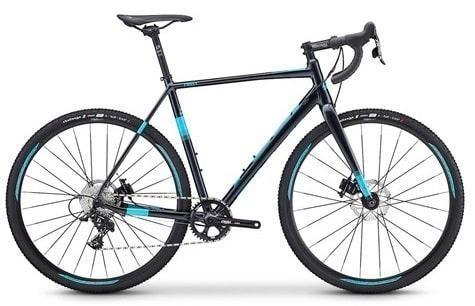
Fuji threw themselves into the gravel world with the Jari, with which they make their own definition of the segment and bet on more of a cycling concept than other brands with three bottle cages and endless possibilities for mounting saddlebags.
With a weight of less than 10 kg, it rolls very well on complicated terrain and allows us to have fewer repairs with its A6-SL super-butted 6066 aluminum frame to focus on one goal: enjoying every ride, whether on roads in poor condition, easy tracks or even trails more suited towards mountain bikes.
One of the big differences is its crankset, the Oval Concepts 300, which has only 1 chainring and forged 6066 crank arms.
The tires equipped on this bike are Challenge Grifo 700 x 33c and are quite comfortable to ride.
Trek 520 Disc
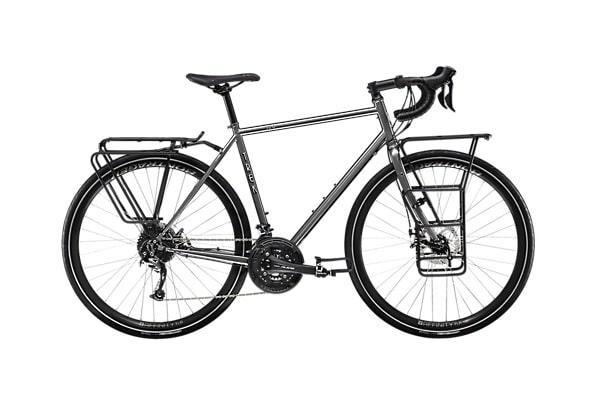
The Trek 520, one of the most famous touring bikes ever produced, is a great option for those of you who are looking to do some bike packing but are not super thrilled about the whole “deep in the woods” type of setting.
This model is a solid option, and there really is not anything that has not been done on a Trek 520 by now. It is also Trek’s longest-running model that they offer, which says something about the popularity of this bike.
The Trek 520 Disc is a steel-framed bike, built with a touring geometry. This makes the bike handle nicely when it is loaded down with gear. It has a wide range of gearing, so you won’t get bogged down on a climb when you’ve got your bags packed full of stuff for your next adventure.
The Trek 520 Disc, as its name implies, features 160mm mechanical disc brakes. It also has tubeless-ready 36-spoke wheels and comes with Bontrager Hard-case Ultimate tires which provide superior flat protection compared to standard tires.
Whether you are just doing a one-night trip to the local campground or are considering a trip across your state, maybe even across the country, the Trek 520 Disc would be a great bike for you.
Everything on it has been optimized for bicycle touring, and it comes with pre-mounted racks. All you need to do is grab your bags, pick a route, and swing your leg over the saddle. The 520 Disc sells for approximately $1,700, and can be bought at the following link.
Surly Bridge Mountain Bike
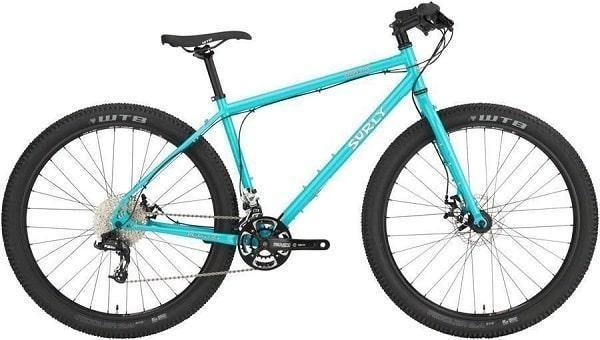
The North American brand Surly is a pioneer when it comes to manufacturing frames and components for adventure bicycles.
It is a bikepacking bike that allows us to alternate riding on trails or on roads. Through its simple design and efficient use of space with a shock absorber, you can carry all kinds of saddlebags.
This bike is quite versatile, so it is not slow on the road and is agile on the trails. As we can see on aventuron.com, this bike is equipped with 100% Surly 4130 CroMoly frame, the main triangle is double-butted, and it has a 1-1 / 8 “threadless CroMoly fork.
The 27.5” wide wheels and a 2.8” pull clearance makes the trip all the more comfortable. The crankset is a 36 / 24T SRAM and the cassette is 10 speeds between 11 and 40 teeth.
A fairly complete bike for a price set to $1200. You can find more information on the following website.
Genesis Vagabond
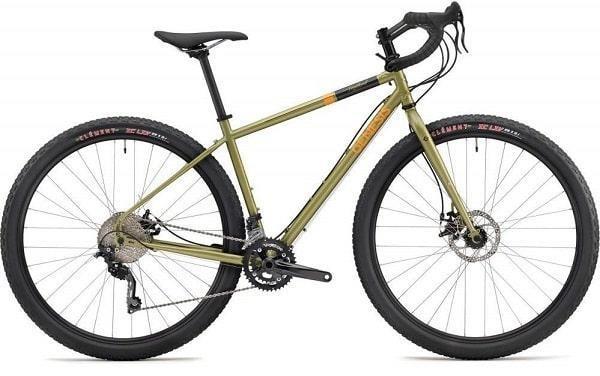
Genesis is a more monster-like bike than gravel. It is very versatile and has an aesthetic between retro and modern that makes it a very attractive bike for the price, which comes in at around $1350.
It has a Genesis Mjolnir Seamless Double-butted Cromoly steel frame and is equipped with 29″ wheels. It is slightly heavier than the Jari at 12.36 kg.
TPR SPYRE mechanical disc brakes are a great choice.
In order to make the bike handle all types of terrain, it features a SAMOX AF12 40 and 28 teeth chainset next to a Shimano Deore cassette of 10 cogs from 11 to 36 teeth.
Overall, a great bike at a price a little more expensive than the Fuji Jari.
Surly ECR +29
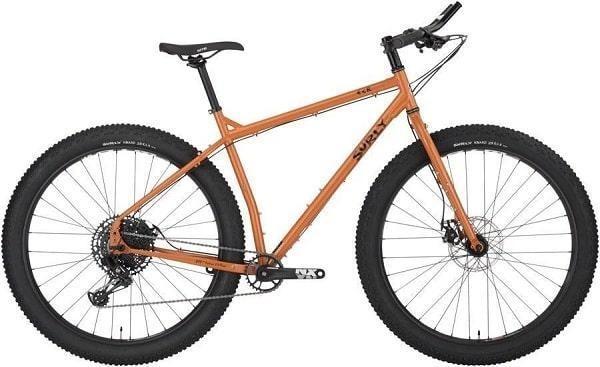
This ECR of Surly bikes is a versatile and solid proposal as its 4130 triple tapered steel frame allows us to accommodate both 27.5” and 29” wheels with up to a 3” tire in both cases.
The frame can easily be purchased for less than € 900, but we recommend the factory assembly of the aventuron.com website with Surly Moloko handlebars, 12v SRAM Eagle group, and 29” x 3” Surly Knard tires.
A great option for those looking for a 100% adventure bike, where simplicity without suspension is what you are looking for.
This simplicity allows the use of luggage rack for saddlebags both in the rear triangle and in the front, as well as double bottle cages on the frame and on both sides of the fork.
It is a touring bike that will delight those who love to travel by bike in a comfortable and relaxed fashion.
Cannondale Topstone Disc SE 105 or Topstone 3 Sora bike
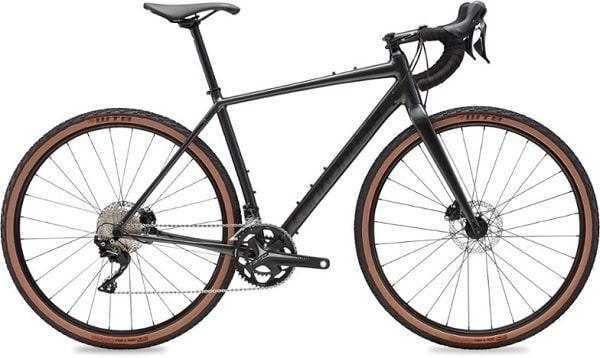
The Topstone is a bike designed for adventure and the road and comes with a very attractive price.
As for its frame, as previously mentioned, it is built with SmartForm C2 Aluminum alloy and has several details that make it an excellent gravel bicycle.
It should be noted that it has several welds with holes to mount all kinds of accessories such as additional drum holders or on the top tube, bag anchors.
In addition, the new frame has enough space to mount tires up to 42mm wide. This causes it to become a bicycle capable of adapting to any type of terrain.
Topstone bicycles can be mounted with a one-plate transmission, or with a compact. In this case, it will depend on the taste of the consumer, and in the case that we are left with a more versatile bike, we would opt for a compact plate option.
The Topstone 105 version is no longer available so now we recommend The Topstone Sora version which comes with 18 gears (2×9) and 700c x 37 mm WTB Riddler Comp tires. Its price is $1,350. More specifications can be found in the following link:
Breezer Radar Pro

This steel gravel bike reminds us of the famous Genesis Croix de Fer. It has classic lines but with top components, such as hydraulic disc brakes.
Though a perfect bike for gravel and bikepacking, but is capable of riding on all terrain. It is equipped with very wide 45mm tires and a Breezer Steel Chromoly frame and fork in which multiple bottles and saddlebags can be anchored.
It has a wide range SRAM drivetrain with 46 / 30T crank, paired with an SRAM cassette with a range of 11 to 36 teeth divided into 10 speeds.
We can find this bike on the-house.com or on the brand’s website.
Trek 920
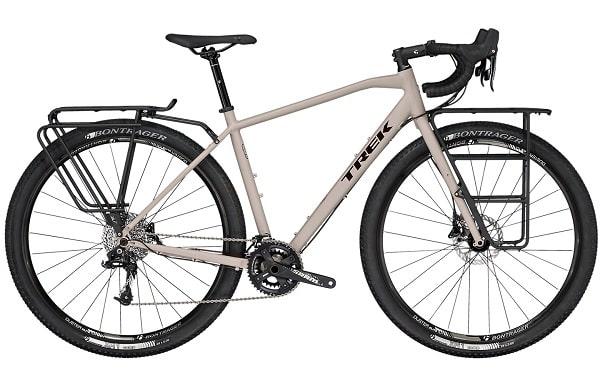
We could not miss this selection as one of the best brands in the market. Trek proposes this touring model for a price of $2100 with the possibility of mounting front and rear luggage racks, as they are sold separately.
An interesting assembly with Alpha Series 100 aluminum frame with 12mm thru-axle, alloy fork with 15mm thru-axle, and SRAM 2 × 10 mountain transmission.
It has 29” tubeless wheels with 2” Bontrager XR1 tires, SRAM S700 hydraulic disc brakes, and 4 extra saddlebags in the frame plus 2 on both sides of the fork. The saddlebags have the capacity to carry up to 25 kg behind and 11 kg in front.
It is a bicycle that will delight bikepackers who do not want to give up an agile geometry and blunt tires in order to face any adventure.
The panel integrates Bluetooth / ANT + sensor compatible with DuoTrap S to register routes or control your fitness status with a computer or a smartphone.
All this on a bike designed for bikepacking weighing less than 13 kg. You can find the full specifications on the Trek website.
Best bikes for bikepacking over $2500 available in 2021:
Salsa Cutthroat GRX 810 or Salsa Cutthroat Apex 1
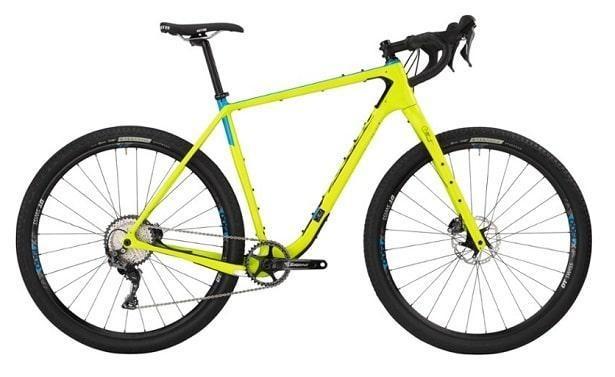
If you enjoy bikepacking, and also like enjoying the finer things in life, then the Salsa Cutthroat GRX 810 is the bike for you. With 29” wheels and a carbon frame this bike will be able to take you wherever the wind blows you, and it will be able to do it in comfort.
The Cutthroat GRX 810 would best be described as a “drop-bar mountain bike”. The frame geometry is going to yield a stable ride whether you are ripping up the single-track or are embarking on a fully loaded bikepacking expedition.
The bike is able to fit up to a 29” x 2.4” tire, so the sky is the limit when it comes to tire choices.
The Shimano GRX 810 groupset has been proven on the gravel-grinder scene, and now finds its way to one of Salsa’s top bikes. You can be sure that this groupset is going to serve you well for a long time and can be depended upon in the backcountry where you might be many miles from a bike shop.
Hydraulic disc brakes provide plenty of stopping power for your rides, and the GRX 810 brake levers have a nonslip coating on them for you to maintain absolute control during aggressive descents or gnarly trails.
The carbon frame has been designed with comfort in mind and was designed around the “Class 5 Vibration Reduction System”, which is supposed to help keep the gravel buzz from interfering with your ride.
Plenty of mounting points are found throughout the frame for attaching everything from bottle cages to racks and top tube bags.
The Salsa Cutthroat GRX 810 is going to be more spendy than other options but is definitely worth it if you don’t mind spending this amount much cash on a bike.
You can be sure that it is going to repay the favor in many, many positive and fun memories. You can buy the Salsa Cutthroat GRX 8120 at REI, for approximately $4,200.
Note: Salsa Cutthroat GRX 8120 is currently unavailable so chech out Salsa Cutthroat Apex 1 Bike instead.
Trek 1120
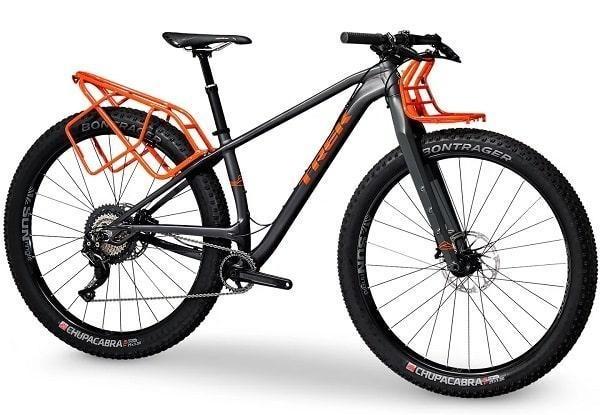
Our first recommended model of more than $2500 is from the well-known Trek brand. It is an ideal bike for bikepacking which incorporates two saddlebags in the front and rear of the bike.
The frame equipped on this bicycle is not steel, but Alpha Platinum aluminum. The 29” wheels are ideal for any bikepacker who wants to ride on unpaved trails. It includes Boost148 space on rear toecaps and 110mm Boost on the carbon fork that is designed to be replaced by a suspension fork if desired.
The transmission includes a unique chainring and an 11-speed cassette (1×11 Shimano drivetrain) and SRAM Level T hydraulic disc brakes.
It is possible to get this magnificent bike made for bikepacking for $2650.
Ghost Fire Road Rage 2019
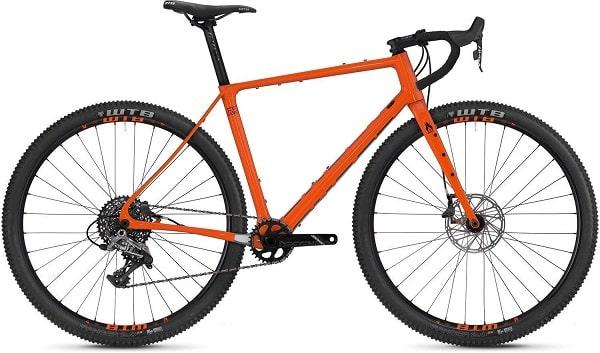
The next bike is the Ghost Fire Road Rage from the German brand Ghost. A bike very suitable for off-road and gravel cycling, although the German brand has cataloged it as a cyclocross bike.
As we can see in the image, the frame is full of anchors to equip saddlebags in it and this is designed in carbon to give the bike as light of a weight as possible. The fork is also made of carbon and makes the bike very versatile off-road.
The tires it has are 29” wide which makes it ideal for rocky and adventure trails.
The bicycle has a very modern design and hides all the brake cables inside the fork and frame.
The drivetrain is an SRAM Rival and Apex1 with 11 speeds. The Apex1 is made for bikes with 1 chainwheel, and the cassette is the SRAM Rival. The chainring is a Truvativ Descendant X-Sync 36T that limits the bike for roads.
It has SRAM Apex disc brakes and the wheels and tires are from WTB. It weighs less than 10 kg. You can find more specifications in the following link.
Trek Farley 9.8
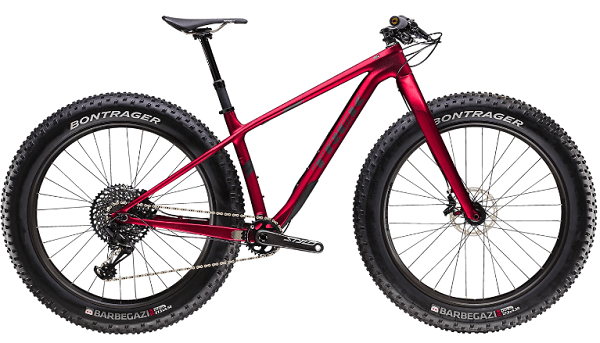
To conclude our selection, we ask ourselves… which is the best bike for bikepacking on snow? To answer the question, we have to turn to fat bikes, and Trek offers us a fantastic bike to do bikepacking in winter, including in snow.
The Trek Farley range has taken a different approach than its competitors and has equipped the bike with smaller tires to give more versatility and adapt it to more circumstances.
The Farley 9.8 is a carbon fat bike designed to provide speed and is quite light with a weight of just over 10 kg.
The lightweight OCLV Mountain Carbon frame, the rigid carbon fork and a 1 x 12 SRAM NX Eagle transmission make it the perfect bike for mountain bikers looking for a high-performance fat bike.
The tires that the Farley equips are 27.5×4.5˝ Bontrager Barbegazi TLR tires.
If you are prepared to give it your all throughout the season and you love fat bikes, whether to compete or to enjoy great adventures, the Farley 9.6 can be your high-performance bike for $5150.
You can check all its specifications in the following link:
Here we presented the TOP 12 bikes ideal for bikepacking, with a wide range of prices, from less than $1000 of the Tommaso Sentiero to $5150 of the Trek Farley.
They are all very different bikes but they all have the aim of making you enjoy your adventure riding along trails and long routes.
Should you pick a mountain bike, gravel bike, or a fat bike?
The three types of bikes that we recommended are Mountain bikes, gravel bikes, and fat bikes. Here’s a bit more about each type.
Mountain Bikes
Why should I buy a mountain bike to practice bikepacking?
The answer is obvious. If the terrain to travel is hilly, along narrow trails and even along trails with stones, this is the bike you will want, although it could be used on all types of terrain.
There are many types of mountain bikes, such as rigid, full suspension, hardtail, etc. The ones that we are going to recommend in this article are the rigid ones.
They are lighter bikes because they do not have the rear suspension system. When the rear suspension is not mounted, all the pedaling power is transmitted.
This type of bike is ideal for absorbing the impact on uneven terrain.
The wheel size does not matter too much, because the bikepacking already adapts to all sizes. But the tires are very, very important.
Look for extra width sizes and always inflate it a little less than the recommended pressure to avoid bouncing (consider that you are going to carry more weight than usual) and increase traction.
Gravel Bikes
Why should I buy a gravel bike to ride with bikepacking?
Gravel bikes are designed to ride for hours, through roads or trails. It is an evolution of road and cyclocross bicycles, and is much more comfortable and stable.
This type of bike allows wider tires that give greater traction and control to the bike. It is ideal for riding on the mountain or flat terrain and especially for long trips.
The limit of these bicycles is set by you. They can either be used to climb mountain passes, or you can put bags in the frame, handlebars or saddles, and make a great randonneuring bike.
Fat Bikes
When should I buy a fat bike for bikepacking?
These bikes are used in bikepacking for the most extreme conditions. They can be used on all types of terrain, but work best on sand and snow.
They are the slowest and you need to be in a good physical condition to ride them. If your route is long, they are not the most advisable.
They are heavier than a mountain bike, obviously, and less reactive, but they are capable of climbing anywhere, thanks to the grip of their huge wheels.
In addition, they are very good at the terrain where the bicycle is especially punished.
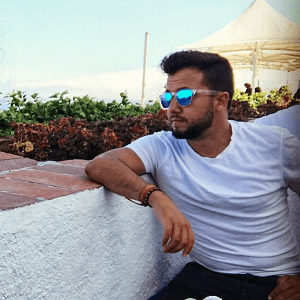
I am Luis Pedraza, Spanish engineer based in Poland for work right now. I used to take place in BTT races in my region when I was younger and now I enjoy the Sierra de gredos and El pielago on my Orbea MX when I visit my hometown. Addicted to Cycling Manager, I used to write about football and cycling on the Internet.



